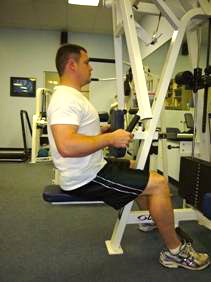Helping with Your New Years Resolution!
Helping with your New Years Resolutions: Getting the most out of your gym workout
One of the most common New Year’s resolutions is to hit the gym in hope of losing weight, getting in shape, or just pursuing a healthier lifestyle. However, people are often confused about the correct way of meeting their goals without getting hurt. Here are some frequently asked questions and some guidelines to help you get the most out of your gym workout.
1. Common mistakes made in the gym.
- Getting over-enthusiastic about your program (early burnout): These people tend to start off by spending too much time in the gym or go every day and lose interest quickly. Do not be afraid to leave the gym, even if your workout goal is not complete. If you are fatigued or tired, continuing your workout will put you at higher risk for injury, which will delay accomplishing your goals.
- Improper form: make sure that a professional shows you how to use every piece of equipment including weight selection, proper mechanics, and methods of adjustment to fit your body.
- Doing more resistance (weights) training in hopes of becoming “ripped”: Losing body fat will allow muscle definition to become more apparent so a proper diet and a lot of cardiovascular exercise will be more effective then weights alone.
2. What are the components of a comprehensive gym program?
- Warm up: including cardiovascular exercise- at least 5 minutes (can include using stationary bike, easy jog, jump roping, elliptical)
- Resistance training divided into 2 separate groups: 1) Arms/shoulders/upper back and 2) Legs/hips/core
- Post-exercise stretching
3. What types of exercises should I perform?
- Cardiovascular: bike, elliptical, treadmill, stair steppers
- Legs/hip/core: Pushing out (leg press), leg extension, leg curl, squats or lunges, core (planks, crunches)
- Arms/shoulders/upper back: Rowing movement (pulling back), pressing movement (pushing forward), overhead press (pushing up), lat pull (pulling down), arm curls (biceps), extensions (triceps).
 4. What if I want to concentrate on a specific area?
4. What if I want to concentrate on a specific area?
- While it is important for overall body health to incorporate the entire body with at least one exercise per muscle group, individuals wishing to concentrate on a specific area may choose to do 3-4 different exercises for one muscle group.
- For example, many exercise enthusiasts choose to perform a bench press (flat, inclined, and declined), flys, and use a peck deck stack weight machine…all of which develop the pectoral (chest) muscles.
5. How many days should I exercise?
While most experts agree that 30 minutes of daily cardiovascular exercise is important, the frequency of gym visits is less definitive. There are 2 different options that allow you to perform a comprehensive program.
- Option #1 (For individuals with limited time each day): Go to the gym 4-6 days per week and choose to work on either the arms/shoulders/upper back on 2-3 days and then the legs/hips/core the other 2-3 days.
- Option #2 (For individuals with large time blocks): Choose 2-3 days per week and perform the entire workout.
- Whichever option works better for your schedule, keep in mind that exercising the same body part without a day’s rest in between may be detrimental and could lead to overuse injury. Muscles require at least 24 hours of rest after a workout to re-build and recovery.
 6. How many sets and how many repetitions?
6. How many sets and how many repetitions?
To get the most balance out of a workout, we suggest performing 3 sets in the following manner:
– Set 1 (Warm up): perform 20 reps with a resistance that is comfortable, but that feels challenging by the 20th and final rep.
– Set 2 (Endurance): add more resistance and perform 15 reps.
– Set 3 (Strength): add even more resistance and perform 10 reps.
– An ideal resistance selection would mean that by the LAST rep, you feel like you can do NO more than 2-3 reps. If you feel like you could continue performing the exercise for several more reps then the weight is too light. If you cannot come within 2-3 reps of the goal for each set (ie. at least 7-8 on the third set), then the weight is too heavy.
7. Free weights versus stack weights (machines)?
- Advantages of stack weights over free weights: they are safer because the motion is controlled.
- Advantage of free weights over stack weights: You are not limited by the motion of the machine so you can have more variety.
Summary
- Make sure that you choose exercises and machines that you are comfortable with.
- Choose a balanced workout routine that fits your time constraints.
- Start out slowly and progress the number of exercises and the amount of resistance in a manner that does not result in burnout or injury.
- Working out with a friend or 2 may make it more enjoyable and increase your compliance and motivation.
- For further questions about getting the most out of a gym program, please email or call The Sports Rehabilitation Center.